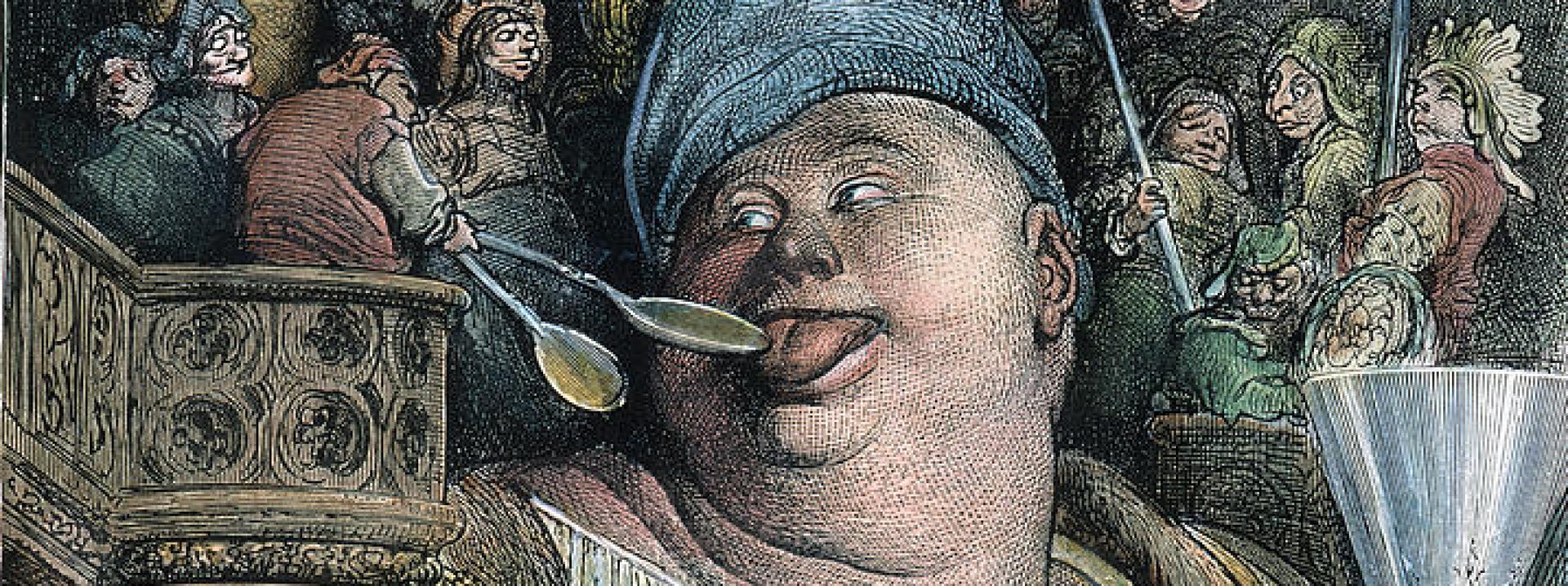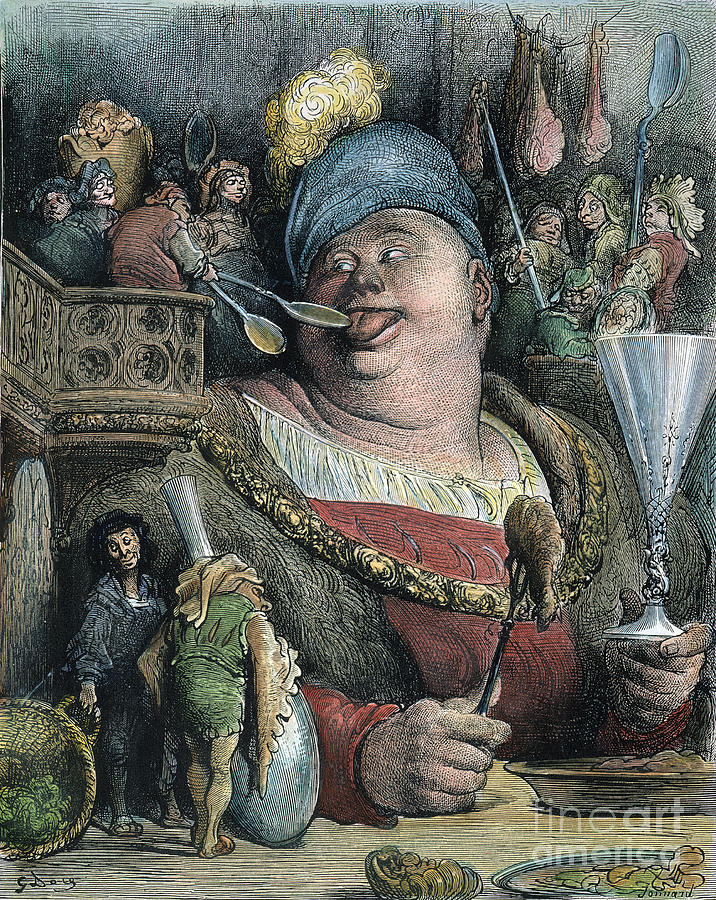Hi y’all. My appetizer is on visualizing scenes from Pantagruel and Gargantua. There are excerpts from Rabelais and images about Pantagruel and Gargantua by Dore below to provide analysis on.
Excerpts from Rabelais and His World
Chapter 5 Rabelais’ world
- “We have also an exaggeration: the symptoms produced by the stutterer’s distress (tension of the eyes, sweat) are increased to such an extent as to typify childbirth.“ pg.309
- “At the same time Pantagruel and his companions made their own preparations in view of the battle. He took 237 casks of wine, filled the ship’s dinghy with salt, and attached it to his belt. He then took a dose of a diuretic. Finally, King Anarchus’ camp was set on fire while the enemy was asleep after a drunken orgy. Suddenly Panurge’s drugs began to take effect and Pantagruel felt an imperious need of draining his bladder. So he voided on their camp so freely and torrentially as to drown them all and flood the countryside ten leagues around.”The enemy has been hacked to pieces,” they exulted. “See the blood run.” But they were mistaken. What they believed in the glow from the burning camp and the dim moonlight to be blood of slaughtered enemies was but the wine from our giant’s bladder.The enemy now awakened thoroughly to see their camp blazing on one hand and Pantagruel’s urinal inundation on the other. They were, so to speak, between the fiery devil and the deep Red Sea. Some vowed the end of the world was at hand, bearing out the prophecy that the last judgment would be by fire. Others were certain they were persecuted by the sea-gods Neptune, Proteus, Triton and others. Certainly the waters flowing over them were salty.” pg. 333
In addition to above excerpts you can draw on topics read and discussed previously in class about Rabelais and both the grotesque and carnivalesque.
Read the excerpts below. Then take a look through the images below and provide your thought on these questions about a few images:
- What is going on in this image? How does it tie to
- What makes this image grotesque/ carnivalesque? Why?
- If not, why?
- Are there limitations to this analysis with looking at pictures?
You’re not limited to these questions. You can discuss what stands out to you with the images.
Images Below with Captions: Images are from Dore’s Illustrations for Rabelais by Gustave Dore
EDIT: More images


These images are a really great way to visualize the Rabelais text– for me, it’s hard to imagine the exaggerated features described in some of the texts we read, so thanks for bringing in these images! I wanted to comment particularly on the last image, the one of Gargantua on the towers of Notre Dame. First, the perspective of the image really highlights how large Gargantua really is. In comparison with the smaller people in the image and the huge building that seems small next to him, Gargantua looks almost god-like. Also, to your second question, there definitely seems to be something Carnivalesque about taking a Grotesque body and comparing it to a sacred or holy structure like Notre Dame. The sacred is somewhat degraded here because it seems small and unimportant next to Gargantua’s huge body. The people in the streets and in the tower in the foreground also are Carnivalesque in that they seem very crowded and look like they are making a lot of noise as well as physical gestures.
I was also particularly struck by the final image. What a big guy! One aspect that I think is particularly carnivalesque about it is that everything else seems alright. There’s a HUGE person ON TOP of Notre Dame and that man in the foreground with his arms up is like “yes! this is great!” A toddler is dangling his legs off the side of the building. There’s no malice in the drawing that I can sense (even Gargantua is just hanging out). As Sophia mentioned, the multitude of people in the square all looking up also gets at the universal body– together, they’re a huge mass observing another huge mass, both independently cohesive bodies and perhaps, following from their relaxed attitude toward one another, one cohesive, communal body. Regarding your last question about whether analyzing these images has limitations: obviously, Rabelais was not in creative control of these visualizations and, as such, they are only avenues to Rabelais at at least one remove. However, they’re great examples of the grotesque in and of themselves, and I think they have value even apart from the novels.
I’m really intrigued by the first image of Gargantua’s birth. With this week’s readings in mind I first assumed that the illustration was a depiction of Pantagruel’s birth. The mother figure looks plenty dead and the father figure has that same ambivalence as Gargantua is described to have had. After realizing my mistake I wanted to know whether there were any Doré illustrations of Pantagruel specifically. Yet so much of the message of this chapter and chapter 8 where Gargantua writes to his son emphasize the cyclical continuity of the human spirit through our communal bodies. Remembering Rabelais’ citation of the Greek figurines of old and dead mothers giving birth to babies, the Doré illustration reinforces this theme visually. It’s grotesquelly realistic by its strong juxtaposition of birth and death and the way it centers Gargantua’s human urge to drink. Although I haven’t read Gargantua, I wouldn’t be surprised if the two giants’ birth stories are very similar. In this way my confusion of who was depicted in the Doré illustration suggests that the exact identity of the characters is not so important. They both embody the Rabelaian spirit of haughty exuberance and mirror each other in their life stories.
Thank you for posting these!
First, I want to thank you all for the great analysis and attention you all drew to different aspects of the images from the incorporation of the sacred to the sheer size of Gargantua. These images were extremely helpful for visualizing the text. Now that everyone has had a look at all of the drawings there are many directions for the discussion to go. I made an edit to the post and added a few Pantagruel illustrations. You can reply to a comment made by someone or comment on the illustrations added.
ps. Dore made a total of 252 illustrations that depict various scenes from Pantagruel and Gargantua.
In the added illustrations, I was drawn to the one of Pantagruel visiting Paris, because it is very reminiscent of the one of Gargantua at Notre Dame that we discussed before, but I feel like the Grotesque and Carnivalesque manifest in some different ways here. What struck me most was the dynamic between Pantagruel and the people of the city. Whereas Gargantua in the Notre Dame image is looking down on everybody in the street as if a divine figure, Pantagruel is walking among them, and some of the people are even positioned above him on rooftops. I think that this creates a more Carnivalesque mood than the image of Gargantua at Notre Dame because it removes hierarchy and points to the aspects of the Carnivalesque that have no ‘footlights.’ Like Gargantua, Pantagruel is still the primary symbol of the Grotesque in this image because of both his size and the apparent over-extravagance of his clothing; however, for me this image conveys the Carnivalesque in a clearer way than the Gargantua Notre Dame image in that the people of Paris seem to be equals of Pantagruel here.
In the pictures you added, I was again struck by just how comfortable everyone is with each other. I’m particularly thinking about Pantagruel testing his wits against the Parisian scholars– Pantagruel is lounging, everyone else is kind of leaning against/into him. There’s a familiar intimacy there that really reflects the mood of the passages we’ve read so far. It also reminds me of Nico’s presentation on sumo wrestling: there doesn’t seem to be a lot of sound or movement going on, but there’s still undeniably one body. I also love that image of Pantagruel riding into Paris on a HUGE horse– the horse is huge! And there are people sitting on roofs, just watching. Thanks for bringing these in!
I can only imagine the size of the horse shit covering the streets of Paris now…
Anyways that scene with the Parisian scholars also seems to me like a perfect space for the type of crude but jovial language and insults that would be considered billingsgate. Like you said, everyone seems relaxed and there’s no visible tension in the room. Sure Pantagruel is probably talking nonsense but how could you not be enraptured by the size of the dude and his awesome presence. You can see byhow crowded the room is that Pantagruel is a very special guest. The billingsgate is also probably transcending boundaries of elite and peasant culture and general and specific humor like you talked about in the reading diary. The illustration also allows us to further imagine the effect of Pantagruel’s embodiement on those around him by observing all the different expressions and postures of the various unnamed scholars. Some are down below craning their necks up and unfortunately closer to where any lower bodily functions can be smelled. Those on the balcony may be strianing under the booming echoes of Pantagruel’s voice and periodically wiping their faces of spittle.
I also wanted to bring the written excerpt into the discussion, because I think it’s interesting to think about whether the Grotesque/Carnivalesque can be put to words in a way that conveys the same feeling as the images. To me, it seems like Rabelais has mastered the ability to make his Grotesque/Carnivalesque scenes tangible with imagery. In the excerpt from chapter 5 that Tia has written out at the top of the presentation, the imagery of all of the people’s reactions to Pantagruel and his body interacting with the world and the people around him is visceral. When reading it, I can imagine it drawn in the same style that Dore has used to illustrate other Rabelais scenes. So to your last question about whether there are limitations to this image analysis, I think that it is really valuable to look at the Grotesque/Carnivalesque in both images and writing because the two styles bring something different to the story and complement each others’ imagery.
First, thank you to Helena, Collin, and Sophia for insightful comments about the appetizer. The purpose of the presentation was to provide images of Gargantua and Pantagruel to remember their sheer size while reading the text. Overall the appetizer went great there were multiple points introduced from remembering size to comparison of the images to the excerpts. As for the quality of the presentation, I could have had less images since the group is only three. However this allowed for more exposure to the world of Gargantua and Pantagruel as seen from Dore. In all this went great for an online appetizer.